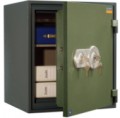Capacity
The volume of the interior space of the safe. Usually this parameter is indicated taking into account the safe-in-safe and other additional internal compartments. The amount of content that can be placed inside directly depends on the volume; on the other hand, it affects the external dimensions and weight of the storage.
Types of locks
The number and types of locks provided in the design of the safe for locking the main compartment.
—
Key. Locks that can be opened/closed in the classical way with a key. The key is convenient in use that you do not have to remember the digital combination. In addition, such a lock is extremely easy to use, and also makes it easier to manage access to the safe: if necessary, the key can be given to another person, and taking it away can deprive him of access without having to reconfigure the lock. On the other hand, the key can be lost or stolen, with corresponding unpleasant consequences; and the danger of opening with a master key should not be ruled out (although in most cases it is rather difficult).
—
Mechanical combination. A mechanical combination lock that can be opened with a numerical code. The code is usually entered by turning a special drum. This type compares favourably with the key one due, in fact, to the absence of a key — to open it, it is enough to know a combination of numbers. On the other hand, the combination requires reliable memory, and the code fixed “just in case” on paper or other media can be not only lost or stolen, but also read without the knowledge of the owner. In addition, the procedure for working with the lock itself is quite complicated and can cause difficulties if you are not used to it. It is also worth considering that some models of such locks
...do not provide the code changing; this point should be clarified when buying.
— Electronic. A lock controlled by electronic circuits and opened with a numerical cipher. Such locks are similar to the mechanical devices described above — but instead of a wheel, they are equipped with conventional numeric keypads, which greatly simplifies the operation. Also, the use of electronics instead of mechanics provides a number of other advantages: the cipher can be easily changed, its length can be longer, the built-in display allows you to control the correctness of the input, etc. Of the significant cons of such locks, it is worth mentioning perhaps the need for power supply, but for a number of reasons this moment does not play a decisive role.
Note that some safes are equipped with locks of different types — usually key and electronic. This makes storage more versatile. Also, individual compartments may differ by type of locks (see "Number of compartments").
— Biometric (fingerprint). A kind of electronic locks, that use the user's fingerprint instead of a key. This option is extremely convenient due to the fact that the user does not need to carry a key with him (at the risk of losing it or being forced to intruder) or remember a numerical combination — he can open the lock by simply placing his finger on the sensor, while the opening of safe will not take a place with the fingerprints of an intruder. Most biometric locks are capable of storing multiple fingerprints in memory, which allows access to multiple people at once and provides additional security in case of failure.Number of key locks
The number of key locks (see "Types of locks") provided in the design of the safe.
Usually, there is one key lock for each separate compartment of the safe (if such a lock is used at all). In such cases, the number of locks is not indicated. However, there are quite a few safes in which the main compartment is equipped with two key locks at once. This design somewhat complicates and increases the cost of the safe, however, it provides an additional security against unauthorized opening of the safe using a master key or damaging the lock — it will be more difficult for an attacker to deal with two locks than with one. Most safes with two key locks are burglar-proof or a gun safe (see "Product Type").
Lock model
This paragraph indicates the manufacturer of the safe lock.
External dimensions (HxWxD)
The size of safe regarding its external dimensions. These figures will allow you to estimate how much space the safe takes up and whether it will fit into the intended installation location. Of course, greater capacity implies larger dimensions.
Internal dimensions (HxWxD)
Dimensions of the interior space of the safe. Note that in our catalog this parameter is indicated without a safe-in-safe, ammo compartment (see below) or other additional compartment provided inside.
This parameter directly determines the internal volume (see below). In addition, with the internal dimensions are known, you can determine whether this or that object will fit inside; this is especially important if you plan to use the safe for large items (for example, large-format documents that cannot be folded) — after all, in different models, the dimensions on three sides can vary significantly even with the same capacity.
Weight
The total weight of the empty safe. Unlike many other products, for safes, heavy weight is usually more of an advantage than a disadvantage: the heavier the safe, the more difficult it is to steal it entirely for later opening in a safe place. The only exceptions are portable and automotive models (see "Product Type") — in their case, theft prevention is ensured primarily by fastening, and in the first case, the product, by definition, must be suitable for carrying in hands.

